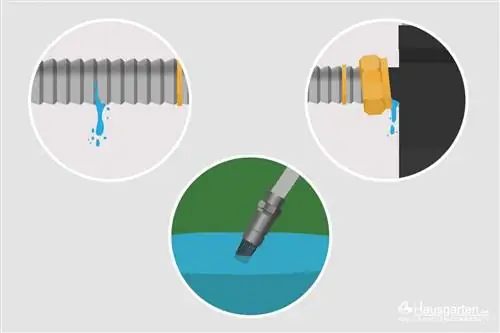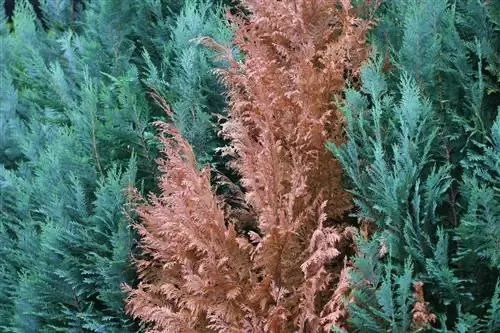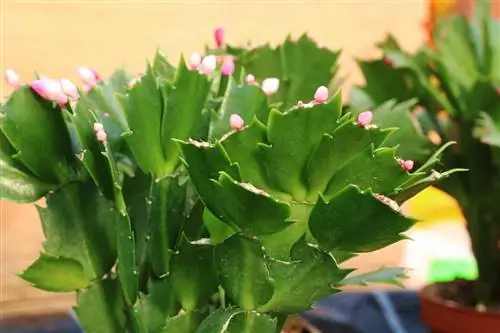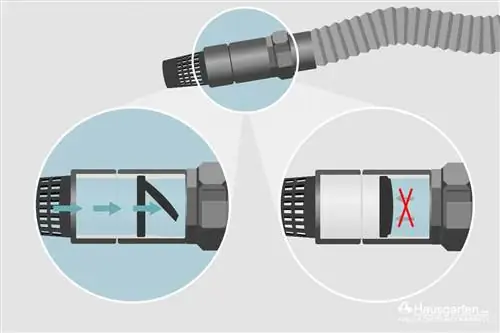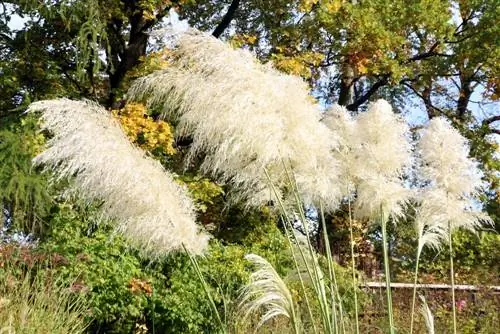- Author admin [email protected].
- Public 2023-12-17 03:39.
- Last modified 2025-01-24 12:45.
A garden pump that doesn't draw water is not only annoying, but it doesn't necessarily lead to buying a new pump. Because numerous malfunctions can be repaired.
Suction height (suction pipe)
The suction height of garden pumps is limited. If the height to be overcome is above the suction height of the pump, no water will be pumped.
Solution
To check whether the suction height is the reason for the lack of water delivery, place the pump at a lower location. If it works without problems there, the suction height of the garden pump is too low at the desired location. If the device absolutely has to be in a higher position, you unfortunately have no choice but to exchange the pump or buy a new one.
Note:
Very good garden pumps have a suction height of seven to eight meters.
Tightness (tightness)
A leak in the suction hose means that water is not pumped. Since the pump cannot suck in water, no water can be transported. The problem also exists if the connections (seals, valves) on the garden pump or the connection points on a hose made up of several elements are not properly sealed.
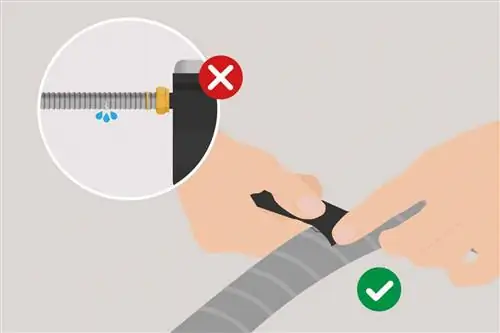
Solution
- If there is suspicion, check the suction hose and connections for leaks
- Replace leaky components
Pressure switch
If the pressure switch is damaged, the garden pump will not make any sounds or show any other reactions.
Solution
Check the voltage on the switch when the pressure switch is closed. If the voltage drop is at the same level as the mains voltage, the switch cannot make contact.
- Clean contact points
- Replacing the pressure switch
Wrong pump type
Garden pumps differentiate between self-priming and non-self-priming types, with only the former drawing and pumping water on its own. If the pump is not self-priming, the suction line must be filled with liquid for the entire period of use. If this is not the case, the device draws no water or only insufficient water.
Solution
- pay attention to the pump type when purchasing
- for non-self-priming devices: place the suction pipe deep enough in the water and fill it with cool water before the first use
Filter
Filters protect against dirt entering the garden pump and clogging it. Because the filters are subjected to heavy use, they wear out more quickly than other device parts. If the filter breaks, the pump becomes clogged.
Solution
- Check filters regularly for wear
- if applicable switch
You can delay the clogging of the sieve or basket filter as follows:
- Weigh down the bucket with some fist-sized stones
- sink in the well or cistern
Now adjust the filter basket or sieve so that the pump sucks the water out of the bucket.
Foot valve
If the foot valve at the lower end of the suction hose is damaged or lost, the pump will not draw water.

Solution
- Check foot valve
- replace a leaky, worn or even missing valve
Mechanical seal
If the mechanical seal is worn, damaged or even torn, there will be a leak between the motor and the pump housing. The cause of the damage to this seal can be:
- the pump is running dry or
- has not been used for a long time.
In addition, water, the abrasive, such as
- Sand,
- Minerals,
- Seeds or other hard substances
contains (abrasive water), which can be the cause of wear of the mechanical seal.
Solution
Replace mechanical seal
Cavitation (formation of vapor bubbles)
Cavitation can damage the motor or the gyro. Causes for the formation of steam bubbles can be:
- a clogged sieve
- a suction button that is too big
- a suction hose that is too long or too small in diameter
Solutions
- clean clogged strainer
- Replace the suction button that is too large with a suitable one
- shorten the suction hose if it is too long
- Replace suction hose with a diameter that is too small with a suitable one
- Repair damage to the engine or gyro
Impeller (spiral)
If the motor hums audibly after switching on but does not turn, this may be because there is dirt or a foreign body in the impeller.
Solution
Remove dirt or foreign bodies
Air
Since not every pump vents itself, air can be the reason why the garden pump no longer draws water. Because over time, air accumulates in the device. If the pump is new, you can assume that there is air in the suction hose.
Solution
Bleede the pump according to the description
Note:
If it turns out that air is the cause of a garden pump that vents automatically, it must be repaired.
Crack in the housing
The most common cause of a cracked garden pump housing is frost. Frost damage occurs when
- the pump was stored too late or
- the water in the garden pump was drained insufficiently or not at all
has been.
Solution
Have the damage checked by a specialist
Shockwater
So-called hammer water creates a sudden back pressure that can damage the pump housing. The reasons for this are:
- Car drives over the pressure-side hose
- sudden interruption of the water supply in the garden hose (quickly turning off the tap, kink of the hose)
Note:
Damage of this type often occurs with very long hoses. They are much rarer for hose lengths under 30 meters.
Solution
Have the damage checked by a specialist
Power supply
If the pump shows no reaction after switching on, this may be because the power supply is interrupted. The reasons for this are
- a break in the cable,
- a blown overload protection or
- blown fuses in the pump
Solution
- Check cable for breaks (resistance measuring device)
- Replace overload protection
- Replace the fuses, start the pump carefully and observe it (find out the reason for the fuses tripping)
Constipation
The blockage of the suction area or suction hose is often the reason why a garden pump does not work properly. It is usually leaves or other plant debris that are blocking the pump. However, mud or soil can also get stuck in the hose.
Solution
- Check the suction hose and suction area for blockages
- remove blocking material
- Gloves protect hands from dangerous content
Note:
If you continue to use the pump despite it being blocked, the hose may break after a while.
Water Depth
Insufficient water depth is often the reason why no water is pumped in submersible pumps (positive displacement pumps). The minimum water level must be high enough for the suction area to be completely submerged. Suction pumps only provide full performance when the suction opening is completely covered with liquid.

Solution
- Check water depth
- Information on the required depth is provided in the instructions for use
- Increase water level

